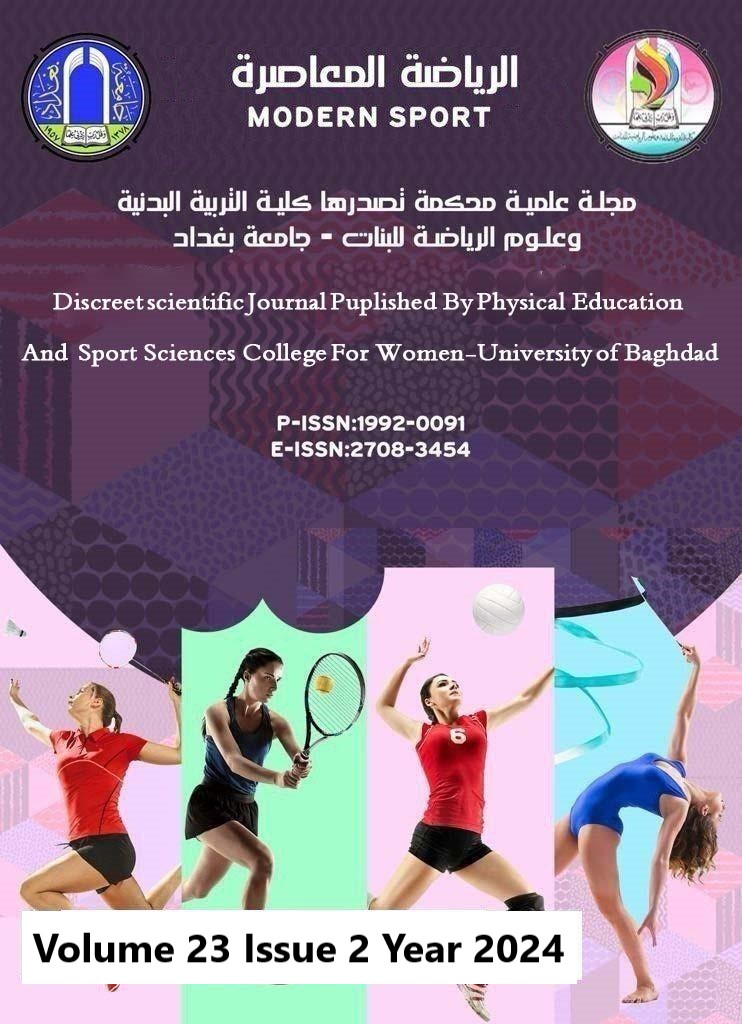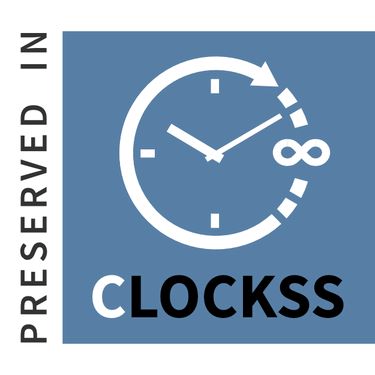Kinematic analysis of the time variable and its relationship to some bio-kinematic variables and the performance of the wheel skill on the floor movements mat for gymnast players aged 7 – 9
DOI:
https://doi.org/10.54702/fb58vq86Keywords:
analytical study, bio-kinematic variables, Technical gymnasticsAbstract
Controlling the time to perform each part of the human wheel movement in a way that serves the goal is one of the important factors that determine the success of the continuity of the movement performance. Therefore, it is very important for the athlete to learn the ability to control how to show acceleration during rotation, and show momentary stillness during balance. The success of executing the human cartwheel depends on the strength and speed of propulsion of the legs and hands, as well as on the mutual relationship between them. It is noted that one of the problems that many players fall into, which causes a decrease in the level of human cartwheel performance, is the weakness of the relationship between time variables in various parts of the movement on the one hand. As well as the weak correlation between time and the rest of the bio-kinematic variables and this leads to not employing the time variable and the bio-kinematic variables in the stages of implementing the human wheel in a way that serves the sequence of the motor path of the movement. The study aimed to kinematicly analyze the time variable and some bio-kinematic variables in the skill of the human wheel, and to identify the relationship between the time variables in the track of the human wheel and the relationship of the time variables with the bio-kinematic variables, as well as the relationship between the performance of the human wheel and the bio-kinematic variables under investigation. The two researchers assumed that there is no statistically significant relationship. Between some time variables in the human wheel track. Likewise, there is no statistically significant relationship between some time variables and some bio-kinematic variables and the performance of the human wheel skill. The research sample included 12 players from the National Center for Nurturing Sports Talent in Gymnastics. The human wheel skill was photographed with a camera with a speed of 120 frames per second, and a group of bio-kinematic variables for parts of the stages were analyzed. The most important results reached by the two researchers: Most of the correlations were significant between time variables for different stages of the human wheel, and this confirms that players realize the importance of time in determining the quality of performance. The emergence of a large number of non-significant relationships between time variables and other bio-kinematic variables, as this indicates Due to the randomness in the use of time in the service of bio-kinematic variables, the non-significant results between time and other variables confirm their lack of harmony and consistency in working with each other. and this achieves one of the sustainable development goals of the United Nations in Iraq which is (Quality Education).
References
- Abdel Hussein. (2010). The effect of special physical-skill exercises according to some biokinematic indicators in developing fluidity, motor transfer, and accuracy of aiming when jumping high with handball. Master’s thesis. University of Baghdad. College of Physical Education for Girls, p102.
- Ibtihal Riad Omran (2021). The effect of corrective exercises according to a model on some biokinematic variables and the performance of the handstand and human wheel skills on a floor movement mat, Council of the College of Physical Education and Sports Sciences for Women /University of Baghdad requirements for Ph.D Degree. p.156
- Ibtihal Riyadh Omran, & Intisar Kadhum Abdulkareem. (2021). The Relative Contribution of the Flexibility for the Hip Joint, the Angle of the Knees, and the Muscular Strength for Arms of Performance of the Front and Back Rolling Skills, Opening on the Floor Movement Mat. Indian Journal of Forensic Medicine & Toxicology, 15(3), 2241–2246. https://doi.org/10.37506/ijfmt.v15i3.15648
- Ban Faisal Al-Azzawi & Boshra kadhim& Entisar kadhim.2019.Contribution of Equilibrium Variables with the High Spike Accuracy of the Position Diagonal Center (4) in the National Volleyball Team .Journl of Global pharma Technology. https://www.jgpt.co.in/index.php/jgpt/article/view/2536
- Debby Mitchell, Barbara Davis, Raim Lopez. ) 2002(. Teaching FUN damental Gymnastics Skillby Stormy ,Library of congress cataloging.p
- George G. S.( 1980 ) . Biomechanics of women's gymnastics, Englewood Cliffs, Prentice Hall. p 106
- Haider Fayyad Al-Amiri (2019). Realistic kinetic analysis system, 1st edition, Al-Najaf Al-Ashraf, Kufa University Press.p.54
- Gareth Irwin & David G. Kerwin (2009) . The influence of the vaulting table on the handspring front somersault, Sports Biomechanics Vol 8(2). p 114,128. https://doi.org/10.1080/14763140902745027
- M. Ibtihal Ryadh Umran, & Dr. Intisar Kadhum Abdul-kareem. (2021). Motor capacity and Its relationship with some indicators Albaiukinmetekih and performance of the wheel of human skill. Modern Sport, 20(2), 0099. https://doi.org/10.54702/msj.2021.20.2.0099
- Muhammad Ibrahim Shehata (1992). Skills Analysis in Gymnastics, Dar Al Maaref, Cairo.p24
- Shahad Kadhum, & Intisar Kadhum. (2022). Calculation of standard degrees of accuracy and speed of transmission from the top and its relationship to some biokinematic indicators at the moment of hitting the ball among junior volleyball players . Modern Sport, 21(3), 0022. https://doi.org/10.54702/msj.2022.21.3.0022
- Sarih Abdul Karim Al-Fadhli (2020). Encyclopedia of the practical application of kinematic laws in sports sciences, Cairo, Al-Kitab Center for Publishing.p 219
- Talha Hossam El-Din et al. (2014). The ABCs of movement sciences, learning and motor learning. 1st edition, Cairo, Modern Book Center.p170
- Talha Hossam El-Din and others (1998). Biomechanics, theoretical and applied foundations, 1st edition, Cairo, Dar Al-Fikr Al-Arabi, p. 92.
- Wajiya Mahjoub (2002). Scientific research and its methods: Baghdad, Dar Al-Kutub and Documents for Printing and Publishing.p 267
- Saeed, W., Abed-Maleh, F., & Jary, H. S. (2019). Effect of Sponge Cylinder Exercises on The Rubber of Working Muscles to Perform Human Wheel Skill in Technical Gymnastics. Indian Journal of Public Health Research & Development, 10(6), 650. http://dx.doi.org/10.5958/0976-5506.2019.01350.0
- wllkerson, Jerry D(1978 ) : kinematics and kinetic analysis of the Back hand spring gymnastics as performed on the balance beam, un published doctoral dissertation Indiana university.p 66
- Zubaida Salah Hadi, Intisar Kadhum Abdul-kareem, & Mohammed Ahmed Abdullah. (2023). The relationship between pushing force and some bio kinematic variables, and the accuracy of the shooting skill while jumping forward in handball. Modern Sport, 22(2), 0021. https://doi.org/10.54702/ms.v22i2.1108
- Zainab Shakir Hammood, & Widad Kadhim Majeed. (2021). Contribution of Some Special Physical Abilities and Biokinematic Indicators to the Accuracy of the Front Strike Performance of Junior Tennis. Indian Journal of Forensic Medicine & Toxicology, 15(3), 2235–2240. https://doi.org/10.37506/ijfmt.v15i3.15647
Downloads
Published
Issue
Section
License
Copyright (c) 2024 Modern Sport

This work is licensed under a Creative Commons Attribution 4.0 International License.















